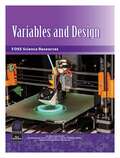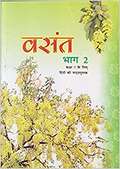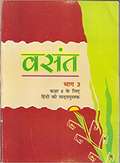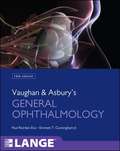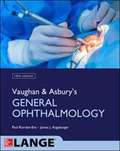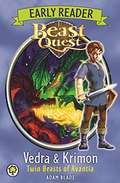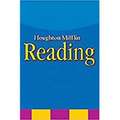- Table View
- List View
Varalaaru (History) 11th Standard - Tamilnadu Board
by Training State Council of Educational ResearchVaralaaru (History) Textbook for the 11th Standard Students, preparing for Tamil Nadu State Board Exam.
Varalaaru (History) 12th Standard - Tamilnadu Board
by Training State Council of Educational ResearchVaralaaru (History) Textbook for the 12th Standard Students, preparing for Tamil Nadu State Board Exam.
Varasa Samjun Ghetana Second Semester FYBA New NEP Syllabus - RTMNU: वारसा समनून घेतांना दुसरे सत्र एफ.वाय.बी.ए. नवीन एन.इ.पी. अभ्यासक्रम - राष्ट्रसंत तुकडोजी महाराज नागपूर विद्यापीठ
by Prof. Dr. Ashwinkumar Rathodवारसा समजून घेतांना या पुस्तकात भौतिक, अमूर्त, नैसर्गिक आणि सांस्कृतिक वारशाच्या संकल्पनांचा सखोल अभ्यास मांडला आहे. जागतिकीकरण आणि शहरीकरणाच्या प्रक्रियेमुळे आपला वारसा धोक्यात येत असल्याने, त्याचे जतन आणि व्यवस्थापन यांचे महत्त्व अधोरेखित करण्यात आले आहे. इतिहास, वास्तुकला, हस्तकला, सण-उत्सव, किल्ले आणि वस्तुसंग्रहालये यांसारख्या घटकांचे महत्त्व विशद करून, वारसा टिकवण्यासाठी आवश्यक उपाययोजना आणि त्याचा पर्यटन व सामाजिक विकासाशी असलेला संबंध स्पष्ट करण्यात आला आहे. पुस्तकातील भाषा सोपी आणि विद्यार्थी-अनुकूल असून, विषय अधिक चांगल्या प्रकारे समजावून सांगण्यासाठी विविध उदाहरणे आणि संदर्भांचा वापर करण्यात आला आहे. त्यामुळे हे पुस्तक विद्यार्थी, संशोधक आणि इतिहासप्रेमींसाठी उपयुक्त ठरते.
Variables & Patterns: Focus on Algebra (Connected Mathematics #3)
by James T. Fey Susan N. Friel Elizabeth Difanis Phillips Patterns Focus on Algebra Glenda Lappan Connected Mathematics VariablesIn Variables and Patterns, you will study some basic ideas of algebra and learn some ways to use those ideas to solve problems and make decisions.
Variables and Design
by Lawrence Hall of Science University of California at BerkeleyNIMAC-sourced textbook
Variables and Patterns: Focus on Algebra
by Glenda Lappan James T. Fey Susan N. Friel Elizabeth Difanis PhillipsNIMAC-sourced textbook
Variables and Patterns: Introducing Algebra (Texas)
by Inc. Glenda Lappan James T. Fey William M. Fitzgerald Susan N. Friel Elizabeth Difanis Phillips WestWordsNIMAC-sourced textbook
Variables y patrones: Enfoque en el Álgebra
by Glenda Lappan James T. Fey Susan N. Friel Elizabeth Difanis PhillipsNIMAC-sourced textbook
Variables: FOSS Science Stories
by University of California at Berkeley Lawrence Hall of ScienceNIMAC-sourced textbook
Vartnatmak Arthashastrachi Olakh-1 First Semester FYB.COMNew NEP Syllabus - SPPU: वर्तनात्मक अर्थशास्त्राची ओळख-1 प्रथम सत्र एफ.वाय.बी.कॉम नवीन एन.इ.पी. अभ्यासक्रम - सावित्रीबाई फुले पुणे यूनिवर्सिटी
by Dr D. G. Ushir Dr S. R. Javale Dr S. R. Pagar Dr S. V. Patilवर्तनात्मक अर्थशास्त्राची ओळख - I हे पुस्तक मानवी वर्तनाच्या अर्थशास्त्रीय अभ्यासावर प्रकाश टाकते. पारंपरिक अर्थशास्त्र मानवी निर्णय तर्कशुद्ध आणि स्वहितसाधक असतात असे गृहीत धरते, मात्र वर्तनात्मक अर्थशास्त्र असे दर्शवते की अनेक वेळा लोक भावनिक, मानसिक, सामाजिक आणि सांस्कृतिक घटकांच्या प्रभावाखाली निर्णय घेतात. हे पुस्तक अर्थशास्त्राच्या उत्क्रांतीपासून सुरू होते आणि त्याचा आंतरशाखीय दृष्टिकोन स्पष्ट करते. यात मागणी आणि पुरवठा विश्लेषण, खर्च संकल्पना, उत्पादन सिद्धांत यांसारखे मूलभूत अर्थशास्त्रीय घटक स्पष्ट करण्यात आले आहेत. विशेषतः, मानवी आर्थिक निर्णय कसे घेतले जातात आणि ते अनेकदा तर्कशुद्ध नसतात हे मानसशास्त्राच्या दृष्टिकोनातून मांडले आहे. तसेच, नीतिशास्त्र आणि अर्थशास्त्र यांचा परस्पर संबंध समजावून सांगताना सामाजिक न्याय, नैतिकता आणि त्यांचा आर्थिक व्यवहारांवर होणारा प्रभाव स्पष्ट केला आहे. हे पुस्तक आकृत्या, तक्ते आणि समीकरणांचा वापर करून संकल्पना सुलभतेने समजावण्याचा प्रयत्न करते. सावित्रीबाई फुले पुणे विद्यापीठाच्या सुधारित अभ्यासक्रमानुसार लिहिले गेलेले हे पुस्तक प्रथम वर्ष वाणिज्य शाखेतील विद्यार्थ्यांसाठी उपयुक्त आहे. याशिवाय, महाराष्ट्रातील इतर विद्यापीठांचे विद्यार्थी, प्राध्यापक तसेच स्पर्धा परीक्षांची तयारी करणाऱ्या विद्यार्थ्यांसाठी हे मार्गदर्शक ठरू शकते. सरळ आणि ओघवत्या भाषेमुळे विद्यार्थ्यांना विषय अधिक सोप्या पद्धतीने समजतो.
Vasahatottara Chintane: ವಸಹತೋತ್ತರ ಚಿಂತನೆ
by C. N. Ramachandranಇದು ಕನ್ನಡ ಸಾಹಿತ್ಯ ವಿದ್ಯಾರ್ಥಿಗಳಿಗೆ ಉಪಯುಕ್ತವಾಗಿದೆ. ಮನುಷ್ಯನ ಚಿಂತನೆಯು ಸಮಾಜದ ಪ್ರತಿಮೆಯಲ್ಲಿ ಅಭಿವ್ಯಕ್ತಿಗೊಂಡಿರುವುದನ್ನು ಕಾಣಬಹುದು.
Vasant Bhag 2 class 7 - NCERT: वसंत भाग 2 कक्षा 7 - एनसीईआरटी
by Rashtriy Shaikshik Anusandhan Aur Prashikshan Parishadयह पाठ्यपुस्तक राष्ट्रीय पाठ्यचर्या की रूपरेखा (2005) के आधार पर तैयार किए गए पाठ्यक्रम पर आधारित है। यह पारंपरिक भाषा-शिक्षण की कई सीमाओं से आगे जाती है। राष्ट्रीय पाठ्यचर्या की नयी रूपरेखा भाषा को विद्यार्थी के व्यक्तित्व का सबसे समृद्ध संसाधन मानते हुए उसे पाठ्यक्रम के हर विषय से जोड़कर देखती है। इस नाते पाठ्यसामग्री का चयन और अभ्यासों में विद्यार्थी के भाषायी विकास की समग्रता को ध्यान में रखा गया है। कई प्रश्न-अभ्यास भाषा शिक्षण की परिचित परिधि से बाहर जाकर प्रकृति, समाज, विज्ञान, इतिहास आदि में विद्यार्थी की जिज्ञासा को नए आयाम देते हैं। पाठ केंद्रित प्रश्नों को क्रमशः विस्तार देते हुए पाठ के आसपास के ज्ञान-क्षेत्रों को भी दूसरे प्रश्न-समूहों में साथ रखने का प्रयास किया गया है। भाषा की बात करते हुए ऐसे शब्दों और प्रयोगों पर विद्यार्थी का ध्यान दिलाया गया है जिन्हें समाज की जीवंतता को साहित्यिक कृतियों में समेटते हुए साहित्यकार अपनी कृति में रखना आवश्यक समझते हैं और अकसर ऐसे आंचलिक शब्द और वाक्य प्रयोग आज के शहरी जीवन में अपेक्षाकृत कम सुनाई पड़ते हैं।
Vasant Bhag 3 class 8 - NCERT: वसंत भाग 3 कक्षा 8 - एनसीईआरटी
by Rashtriy Shaikshik Anusandhan Aur Prashikshan Parishadकक्षा 8 के लिए हिंदी की पाठ्यपुस्तक, एन.सी.ई.आर.टी. इस पुस्तक की रचना के लिए बनाई गई पाठ्यपुस्तक निर्माण समिति के परिश्रम के लिए कृतज्ञता व्यक्त करती है। परिषद् भाषा सलाहकार समिति के अध्यक्ष प्रोफ़ेसर नामवर सिंह और इस पुस्तक के मुख्य सलाहकार प्रोफ़ेसर पुरुषोत्तम अग्रवाल की विशेष आभारी है। इस पाठ्यपुस्तक के विकास में कई शिक्षकों ने योगदान किया, इस योगदान को संभव बनाने के लिए हम उनके प्राचार्यों के आभारी हैं। हम उन सभी संस्थाओं और संगठनों के प्रति कृतज्ञ हैं जिन्होंने अपने संसाधनों, सामग्री तथा सहयोगियों की मदद लेने में हमें उदारतापूर्वक सहयोग दिया। हम माध्यमिक एवं उच्च शिक्षा विभाग, मानव संसाधन विकास मंत्रालय द्वारा प्रोफ़ेसर मृणाल मीरी एवं प्रोफ़ेसर जी.पी. देशपांडे की अध्यक्षता में गठित निगरानी समिति (मॉनिटरिंग कमेटी) के सदस्यों को अपना मूल्यवान समय और सहयोग देने के लिए धन्यवाद देते हैं।
Vasant Bhag-1 class 6 - NCERT - 23: वसंत भाग-१ ६वीं कक्षा - एनसीईआरटी - २३
by Rashtriy Shaikshik Anusandhan Aur Prashikshan Parishadवसंत भाग-१ यह किताब राष्ट्रीय पाठ्यचर्या की रूपरेखा (2005) के आधार पर तैयार किए गए पाठ्यक्रम पर आधारित है। यह पारंपरिक भाषा शिक्षण की कई सीमाओं से आगे जाती है। राष्ट्रीय पाठ्यचर्या की नयी रूपरेखा भाषा को बच्चे के व्यक्तित्व का सबसे समृद्ध संसाधन मानते हुए उसे पाठ्यक्रम के हर विषय से जोड़कर देखती है। इस नाते पाठ्यसामग्री का चयन और अभ्यासों में बच्चे के भाषायी विकास की समग्रता को ध्यान में रखा गया है। कई अभ्यास-प्रश्न भाषा शिक्षण की परिचित परिधि से बाहर जाकर प्रकृति, समाज, विज्ञान, इतिहास आदि में बच्चे की जिज्ञासा को नए आयाम देते हैं। उदाहरण के लिए शमशेर बहादुर सिंह की कविता 'चाँद से थोड़ी सी गप्पें' में दिया गया एक प्रश्न चंद्रमा की कलाओं के बारे में है और सुभद्रा कुमारी चौहान की कविता 'झाँसी की रानी' में इतिहास और भूगोल के भी कुछ प्रश्न दिए गए हैं। ऐसे प्रश्नों के ज़रिए बच्चों को हिंदी की विपुल शब्द-संपदा के विविध हिस्सों का स्पर्श मिलेगा। वे आज के शहरी जीवन में अपेक्षाकृत कम सुनाई पड़ने वाले शब्दों और प्रयोगों को अपना सकेंगे।
Vasant Bhag-2 class 7 - NCERT - 23: वसंत भाग-२ ७वीं कक्षा - एनसीईआरटी - २३
by Rashtriy Shaikshik Anusandhan Aur Prashikshan Parishadवसंत भाग २ यह पाठ्यपुस्तक राष्ट्रीय पाठ्यचर्या की रूपरेखा (2005) के आधार पर तैयार किए गए पाठ्यक्रम पर आधारित है। यह पारंपरिक भाषा-शिक्षण की कई सीमाओं से आगे जाती है। राष्ट्रीय पाठ्यचर्या की नयी रूपरेखा भाषा को विद्यार्थी के व्यक्तित्व का सबसे समृद्ध संसाधन मानते हुए उसे पाठ्यक्रम के हर विषय से जोड़कर देखती है। इस नाते पाठ्यसामग्री का चयन और अभ्यासों में विद्यार्थी के भाषायी विकास की समग्रता को ध्यान में रखा गया है। कई प्रश्न-अभ्यास भाषा शिक्षण की परिचित परिधि से बाहर जाकर प्रकृति, समाज, विज्ञान, इतिहास आदि में विद्यार्थी की जिज्ञासा को नए आयाम देते हैं। पाठ केंद्रित प्रश्नों को क्रमशः विस्तार देते हुए पाठ के आसपास के ज्ञान-क्षेत्रों को भी दूसरे प्रश्न-समूहों में साथ रखने का प्रयास किया गया है।
Vasant Bhag-3 class 8 - NCERT - 23: वसंत भाग ३ ८वीं कक्षा - एनसीईआरटी - २३
by Rashtriy Shaikshik Anusandhan Aur Prashikshan Parishadवसंत भाग 3 कक्षा 8 के लिए हिंदी की पाठ्यपुस्तक। यह पुस्तक हिंदी के भाषा संसार में अनेक बोली-भाषा और क्षेत्रीय प्रभावों का समावेश है। ये भाषा संसार के पोषक अंग हैं और धरोहर भी। जब पाठों में आंचलिक पहचान के साथ रचे गए किसी साहित्य को रखा जाता है तब उसमें लोक प्रचलित शब्द, मुहावरे और क्षेत्रीय परिवेश का चित्रण होता है। कथ्य और कथा परिवेश को तो पाठक पहचान लेता है परंतु भाषा के क्षेत्रीय तत्व अन्य क्षेत्र के पाठकों के लिए अपरिचित होते हैं। इस तरह का साहित्य भाषा के स्तर पर नया अनुभव भी देता है। पाठ चयन करते हुए विषयों के साथ विधाओं का स्तबक बनाने का प्रयास किया गया है। इस गुलदस्ते में यदि एक विषय निबंध की विधा में है तो उसी विषय को दूसरे तेवर में प्रस्तुत करने वाली कविता के चयन का प्रयास भी किया गया है। विविध भाषा-परिवेशों से विद्यार्थी को परिचित कराना भाषा शिक्षण की एक महत्वपूर्ण आवश्यकता है। पुस्तक में इसकी पूर्ति का प्रयास किया गया है।
Vastrashastra Class 12 - Maharashtra Board: वस्त्रशास्त्र इयत्ता बारावी - महाराष्ट्र बोर्ड
by Maharashtra Rajya Pathyapustak Nirmiti Va Abhysakram Sanshodhan Mandal Puneवस्त्रशास्त्र इयत्ता बारावी हे पुस्तक महाराष्ट्र राज्य पाठ्यपुस्तक निर्मिती व अभ्यासक्रम संशोधन मंडळ, पुणे यांनी लेखन केले आहे तसेच श्री. विवेक उत्तम गोसावी यांनी हे पुस्तक मराठी भाषेमध्ये प्रकाशित केले आहे. ह्या पाठ्यपुस्तकातील अभ्यासक्रम सुधारित असून त्यात वैशिष्टयपूर्ण अशा मानवनिर्मित तंतू आणि त्याचे आपल्या दैनंदिन जीवनात सतत वाढत जाणारे उपयोग, रंगाई, छपाई व फॅशन डिझायनिंग यांच्याशी संबंधित प्रकरणांचा समावेश करण्यात आला आहे. हे पाठ्यपुस्तक अशा विद्यार्थ्यांसाठी तयार करण्यात आले आहे, ज्यांना वस्त्रशास्त्राचे विविध पैलू, त्याचा वैभवशाली प्राचीन इतिहास आणि हल्ली प्रचलित असलेला कल याचे ज्ञान प्राप्त करण्याची इच्छा आहे. तुम्हांला वस्त्रशास्त्राची निगडीत विविध क्षेत्रांची रूपरेषा दाखविल्यावर भर देण्यात आला आहे.
Vastrashastra class 11 - Maharashtra Board: वस्त्रशास्त्र इयत्ता अकरावी - महाराष्ट्र बोर्ड
by Maharashtra Rajya Pathyapustak Nirmiti Va Abhysakram Sanshodhan Mandal Puneवस्त्रशास्त्र इयत्ता ११ वी या विषयाच्या पाठ्यपुस्तकाची आकर्षक स्वरूपाची प्रत आहे. सद्यस्थितीतील संकल्पनांचे ज्ञान, नवीन नैसर्गिक तंतूचा विकास, त्यांचे स्वरूप, उगम, उत्पादन, उपयोग व काळजी या बाबींद्वारे अभ्यासक्रम सुधारित करण्यात आला आहे. वस्त्रांचे क्रियाशील उत्पादन, हातमागाची वस्त्रे (हॅन्डलूम क्लॉथ) आणि भारतातील विविध राज्यातील वस्त्रांचा उपयोग यांचे मूलभूत ज्ञान प्राप्त करावयाचे आहे, अशा विद्यार्थ्यांकरीता हा अभ्यासक्रम तयार करण्यात आला आहे. विविध प्रकारचे वस्त्र, त्यांची पारंपरिक ऐतिहासिक पार्श्वभूमी, त्यांची सजावट, डिझाईन, धुलाईची उपकरणे, त्यांचा वापर याविषयीचे विस्तृत विचार, माहिती यांचा समावेश पुस्तकातील घटकांमध्ये करण्यात आला आहे. प्रत्येक घटकाचा उपयोग समजण्यासाठी या अभ्यासक्रमात विद्यार्थ्यांना प्रात्यक्षिक ज्ञान देण्यात आले आहे.
Vaughan & Asbury's General Ophthalmology (Eighteenth Edition)
by Paul Riordan-Eva Emmett T. CunninghamGeneral Ophthalmology is a concise, current, and authoritative review of the subject for medical students, ophthalmology residents, practicing ophthalmologists, nurses, optometrists, and colleagues in other fields of medicine and surgery, as well as health-related professionals.
Vaughan And Asbury's General Ophthalmology
by Paul Riordan-Eva James AugsburgerFor nearly six decades, Vaughan & Asbury’s General Ophthalmology has offered authoritative, state-of-the-art coverage of the diagnosis and treatment of all major ophthalmic diseases, as well as neurological and systemic diseases causing visual disturbances. It is recognized world wide as essential reading for medical students, ophthalmology residents, practicing ophthalmologists, nurses, optometrists, clinicians in other fields of medicine and surgery, as well as those in health-related professions. <p><p> The Nineteenth Edition builds on this tradition of excellence by offering a new full-color presentation, an increased number of color photos, and cutting-edge content additions and updates – to deliver all-inclusive coverage that encompasses pathophysiology, basic science, and the latest clinical perspectives. <p> If you are in need of a concise, up-to-date, and well-written overview of the basics of ophthalmology, Vaughan & Asbury’s General Ophthalmology, Nineteenth Edition belongs on your desk.
Vedra & Krimon Twin Beasts of Avantia (Beast Quest Early Reader #1)
by Adam BladeNew Beasts have been created in Avantia - twin dragons Vedra and Krimon. But the Wizard Malvel plans to capture them, so Tom must take the dragons into hiding. Can Tom save the twin Beasts from the wizard's evil spell?Beast Quest Early Readers are perfect for children learning to read and for families to enjoy together, with text vetted by a literacy expert and bright new colour illustrations.Look out for another Beast Quest Early Reader soon: Kragos and Kildor the Two-headed Demon!
Veema Vyavsayachi Multatve-2 Second Semester FYB.COM New NEP Syllabus - SPPU: विमा व्यवसायाची मूलतत्त्वे-२ दुसरे सत्र एफ.वाय.बी.कॉम नवीन एन.इ.पी. अभ्यासक्रम - सावित्रीबाई फुले पुणे यूनिवर्सिटी
by Dr Shrikant Maruti Phulsundar Dr Pratap Jagannath Falphale Dr Ganesh Raghunath Jaitmal‘विमा व्यवसायाची मूलतत्त्वे-2’ हे पुस्तक विम्याच्या प्राथमिक व दुय्यम संकल्पनांवर आधारित आहे. विम्याचा अर्थ, महत्त्व, तत्त्वे, आणि विमा करारांचे प्रकार सविस्तरपणे समजावून सांगितले आहेत. जीवन विमा, सर्वसाधारण विमा, आरोग्य विमा यांसारख्या विमा प्रकारांचे स्वरूप, त्यांची वैशिष्ट्ये आणि व्याप्ती स्पष्ट करण्यात आली आहे. जोखीम व्यवस्थापन व विम्यातील उदयोन्मुख प्रवाह, तंत्रज्ञान, आणि नवकल्पनांचा समावेश यात आहे. पुस्तक विमा व्यवसायाच्या सामाजिक, आर्थिक आणि वाणिज्यिक महत्त्वावर प्रकाश टाकते, तसेच विमा व्यवसायातील नियामक बदल, त्यांचे परिणाम आणि भविष्यातील संधी यांचे विश्लेषण करते. यामुळे विद्यार्थ्यांना विमा व्यवसायाचा व्यापक दृष्टिकोन मिळतो आणि व्यावसायिक दृष्टिकोनातून विमा व्यवसाय समजण्यास मदत होते. विम्याच्या सैद्धांतिक आणि व्यावहारिक अंमलबजावणीचे महत्त्व या पुस्तकाद्वारे सहजपणे शिकता येते.
Veena Bhag-1 class 3 - NCERT - 23: वीणा भाग-१ ३रीं कक्षा - एनसीईआरटी - २३
by Rashtriy Shaikshik Anusandhan Aur Prashikshan Parishad"वीणा" तीसरी कक्षा के छात्रों के लिए हिंदी पाठ्यपुस्तक है, जिसमें छात्रों के संपूर्ण विकास पर ध्यान केंद्रित किया गया है। यह पुस्तक राष्ट्रीय शिक्षा नीति 2020 और राष्ट्रीय पाठ्यचर्या की रूपरेखा 2023 के निर्देशों का पालन करती है। इसे पाँच इकाइयों में विभाजित किया गया है, जो बच्चों के पर्यावरण, मित्रता, खेल, श्रम और देशभक्ति जैसे महत्वपूर्ण विषयों को कवर करती हैं। पुस्तक में कविताएँ, कहानियाँ, निबंध, पत्र, संवाद और पहेलियाँ शामिल हैं, जो बच्चों के सोचने, समझने और प्रश्न पूछने की क्षमता को विकसित करने में सहायक हैं। पुस्तक के माध्यम से बच्चों को भारतीय पौराणिक कथा परंपरा से लेकर आधुनिक और तकनीकी रूप से विकसित भारत की छवि से परिचित कराया गया है। इसमें भाषा के सौंदर्यशास्त्रीय, सामाजिक, सांस्कृतिक, मनोवैज्ञानिक और साहित्यिक पक्षों को भी शामिल किया गया है, जिससे बच्चे केवल नियमबद्ध व्यवस्था के रूप में भाषा को न देखें, बल्कि इसके विभिन्न पहलुओं को भी समझें। इसके अलावा, पुस्तक में समावेशन, बहुभाषिकता, जेंडर समानता और सांस्कृतिक जुड़ाव को भी महत्व दिया गया है। यह पुस्तक बच्चों के सीखने की प्रक्रिया को आनंदमय और लाभप्रद बनाने के उद्देश्य से तैयार की गई है, ताकि वे सहजता से अपने मध्य स्तर में प्रवेश कर सकें और समग्र रूप से विकसित हो सकें।
Vemana Padyalu
by Yogi VemanaVemana is a famous poet in Telugu who has tried to tell complex philosophies in simple words for a common person to understand easily. He is both witty and sarcastic in his poems and is a very commonly known poet in Telugu

